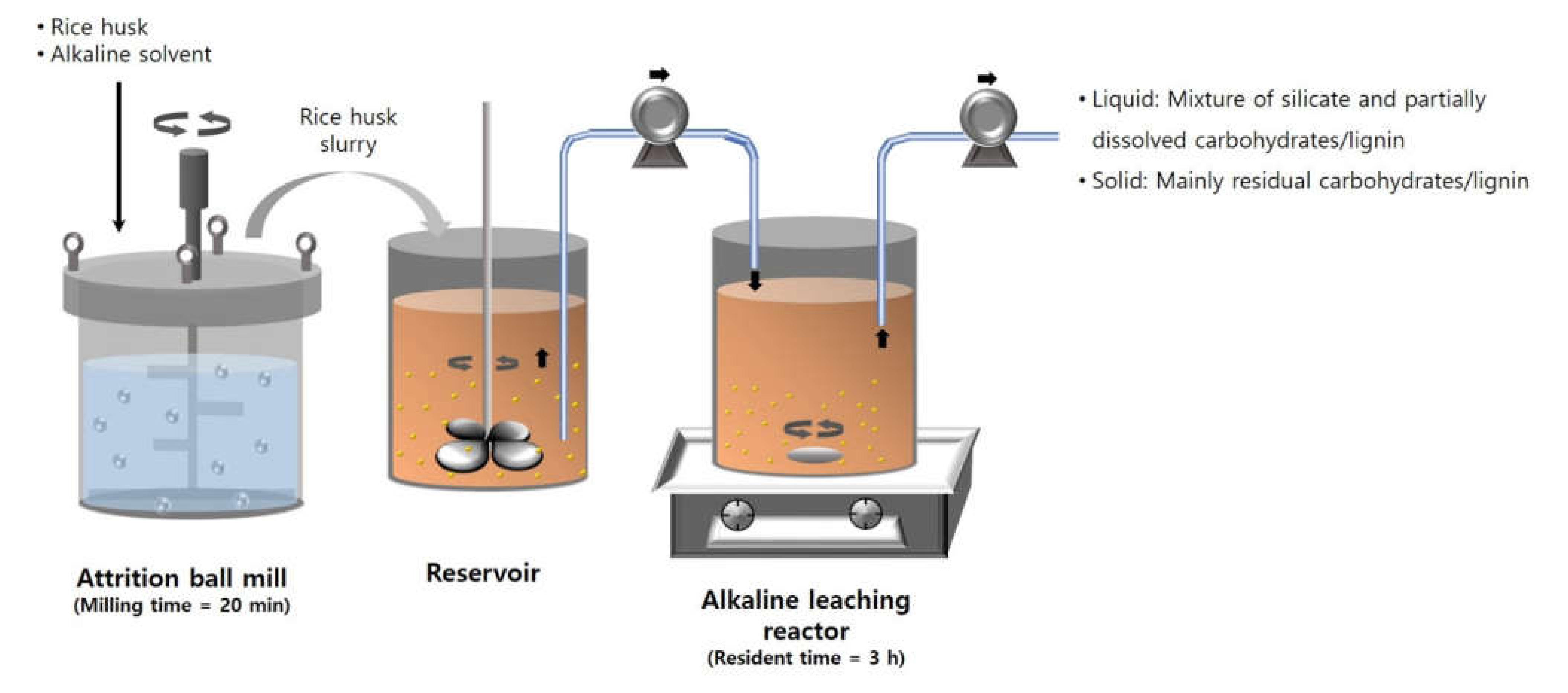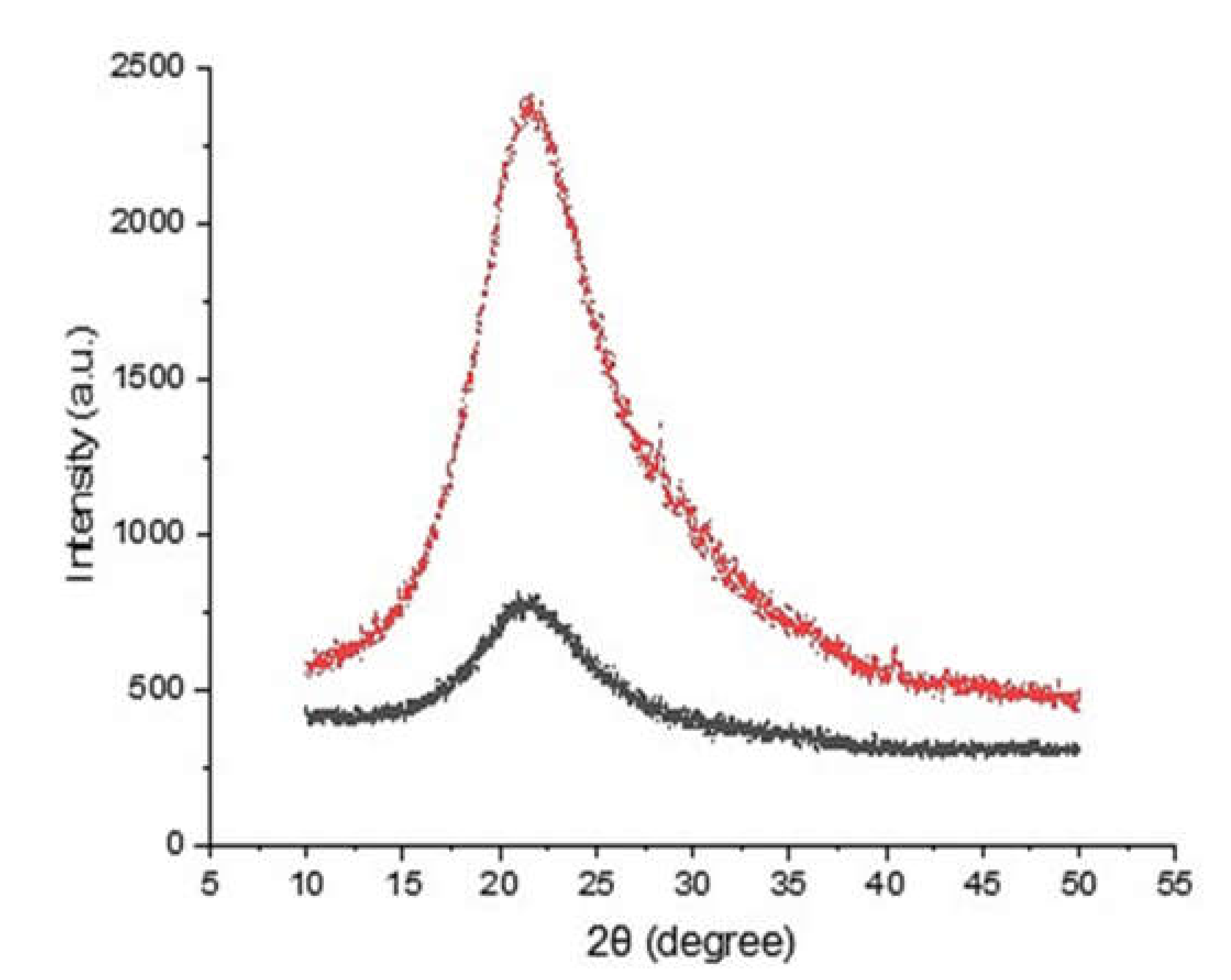Two-Stage Continuous Process for the Extraction of Silica from Rice Husk Using Attrition Ball Milling and Alkaline Leaching Methods
Abstract
:1. Introduction
2. Materials and Methods
2.1. Materials
2.2. Alkaline Leaching Process
2.3. Attrition Ball Mill
2.4. Two-Stage Continuous Silica Extraction Process
2.5. Analytical Methods
3. Results and Discussion
3.1. Optimization of Alkaline Leaching Conditions
3.2. Preparation of Rice Husk Slurry for Continuous Process
3.3. Continuous Silica Extraction Process
3.4. Characterization of the Silica Obtained from the Continuous Extraction Process
4. Conclusions
Author Contributions
Funding
Institutional Review Board Statement
Informed Consent Statement
Data Availability Statement
Conflicts of Interest
References
- FAOSTAT. 2019. Available online: http://www.fao.org/faostat/en/#data/QC (accessed on 12 November 2020).
- Esa, N.M.; Ling, T.B.; Peng, L.S. By-products of rice processing: An overview of health benefits and applications. J. Rice Res. 2013, 1, 107. [Google Scholar] [CrossRef] [Green Version]
- Pode, R. Potential applications of rice husk ash waste from rice husk biomass power plant. Renew. Sustain. Energy Rev. 2016, 53, 1468–1485. [Google Scholar] [CrossRef]
- Babaso, P.N.; Sharanagouda, H. Rice Husk and Its Applications: Review. Int. J. Curr. Microbiol. Appl. Sci. 2017, 6, 1144–1156. [Google Scholar] [CrossRef]
- Lee, J.H.; Kwon, J.H.; Lee, J.-W.; Lee, H.-S.; Chang, J.H.; Sang, B.-I. Preparation of high purity silica originated from rice husks by chemically removing metallic impurities. J. Ind. Eng. Chem. 2017, 50, 79–85. [Google Scholar] [CrossRef]
- Hossain, S.S.; Mathur, L.; Roy, P. Rice husk/rice husk ash as an alternative source of silica in ceramics: A review. J. Asian Ceram. Soc. 2018, 6, 299–313. [Google Scholar] [CrossRef]
- Mason, S.; Young, S.; Araga, M.; Butler, A.; Lucas, R.; Milleman, J.L.; Milleman, K.R. Stain control with two experimental dentin hypersensitivity toothpastes containing spherical silica: A randomised, early-phase development study. BDJ Open 2019, 5, 8. [Google Scholar] [CrossRef] [Green Version]
- Caldona, E.B.; Sibaen, J.W.; Tactay, C.B.; Mendiola, S.L.D.; Abance, C.B.; Añes, M.P.; Serrano, F.D.D.; De Guzman, M.M.S. Preparation of spray-coated surfaces from green-formulated superhydrophobic coatings. SN Appl. Sci. 2019, 1, 1657. [Google Scholar] [CrossRef] [Green Version]
- Mozumder, M.S.; Mourad, A.-H.I.; Pervez, H.; Surkatti, R. Recent developments in multifunctional coatings for solar panel applications: A review. Sol. Energy Mater. Sol. Cells 2019, 189, 75–102. [Google Scholar] [CrossRef]
- Fytianos, G.; Rahdar, A.; Kyzas, G.Z. Nanomaterials in Cosmetics: Recent Updates. Nanomaterials 2020, 10, 979. [Google Scholar] [CrossRef]
- Foletto, E.L.; Gratieri, E.; De Oliveira, L.H.; Jahn, S.L. Conversion of rice hull ash into soluble sodium silica. Mater. Res. 2006, 9, 335–338. [Google Scholar] [CrossRef] [Green Version]
- Rojas, D.F.H.; Gomez, P.P.; Rivera, A.R. Synthesis and characterisation of submicron silica particles from rice husk. Green Mater. 2018, 6, 15–22. [Google Scholar] [CrossRef] [Green Version]
- De Souza, M.; Magalhães, W.; Persegil, M. Silica Derived from Burned Rice Hulls. Mater. Res. 2002, 5, 467–474. [Google Scholar] [CrossRef]
- Chun, J.; Gu, Y.M.; Hwang, J.; Oh, K.K.; Lee, J.H. Synthesis of ordered mesoporous silica with various pore structures using high-purity silica extracted from rice husk. J. Ind. Eng. Chem. 2020, 81, 135–143. [Google Scholar] [CrossRef]
- Costa, J.A.; Paranhos, C.M. Systematic evaluation of amorphous silica production from rice husk ashes. J. Clean. Prod. 2018, 192, 688–697. [Google Scholar] [CrossRef]
- Song, S.; Cho, H.-B.; Kim, H.T. Surfactant-free synthesis of high surface area silica nanoparticles derived from rice husks by employing the Taguchi approach. J. Ind. Eng. Chem. 2018, 61, 281–287. [Google Scholar] [CrossRef]
- Zulkifli, N.S.C.; Ab Rahman, I.; Mohamad, D.; Husein, A. A green sol–gel route for the synthesis of structurally controlled silica particles from rice husk for dental composite filler. Ceram. Int. 2013, 39, 4559–4567. [Google Scholar] [CrossRef]
- Singh, B. Rice husk ash. In Waste and Supplementary Cementitious Materials in Concrete; Woodhead Publishing: Cambridge, UK, 2018; pp. 417–460. [Google Scholar]
- He, C.; Chen, X.; Wang, J.; Ni, H.; Xu, Y.; Zhou, H.; Xiong, Y.; Shen, X. Conveying characteristics and resistance characteris-tics in dense phase pneumatic conveying of rice husk and blendings of rice husk and coal at high pressure. Powder Technol. 2012, 227, 51–60. [Google Scholar] [CrossRef]
- Stegmann, P.; Londo, M.; Junginger, M. The circular bioeconomy: Its elements and role in European bioeconomy clusters. Resour. Conserv. Recycl. X 2020, 6, 100029. [Google Scholar] [CrossRef]
- Vea, E.B.; Romeo, D.; Thomsen, M. Biowaste valorization in a future circular bioeconomy. Procedia CIRP 2018, 69, 591–596. [Google Scholar] [CrossRef]
- Gu, Y.M.; Byun, H.R.; Kim, Y.-H.; Park, D.-Y.; Lee, J.H. Assessing the potential of facile biofuel production from corn stover using attrition mill treatment. Water-Energy Nexus 2019, 2, 46–49. [Google Scholar] [CrossRef]
- Sluiter, A.; Hames, B.; Ruiz, R.; Scarlata, C.; Sluiter, J.; Templeton, D. Determination of Structural Carbohydrates and Lignin in Biomass; National Renewable Energy Laboratory: Golden, CO, USA, 2008. [Google Scholar]
- He, M.; Wang, Y.; Forssberg, E. Slurry rheology in wet ultrafine grinding of industrial minerals: A review. Powder Technol. 2004, 147, 94–112. [Google Scholar] [CrossRef]
- Senapati, P.K.; Panda, D.; Parida, A. Predicting Viscosity of Limestone–Water Slurry. J. Miner. Mater. Charact. Eng. 2009, 8, 203–221. [Google Scholar] [CrossRef]
- Tangsathitkulchai, C.; Austin, L. Rheology of concentrated slurries of particles of natural size distribution produced by grinding. Powder Technol. 1988, 56, 293–299. [Google Scholar] [CrossRef]
- Chun, J.; Lee, J.H. Recent Progress on the Development of Engineered Silica Particles Derived from Rice Husk. Sustainability 2020, 12, 10683. [Google Scholar] [CrossRef]
- Zareihassangheshlaghi, A.; Dizaji, H.B.; Zeng, T.; Huth, P.; Ruf, T.; Denecke, R.; Enke, D. Behavior of Metal Impurities on Surface and Bulk of Biogenic Silica from Rice Husk Combustion and the Impact on Ash-Melting Tendency. ACS Sustain. Chem. Eng. 2020, 8, 10369–10379. [Google Scholar] [CrossRef]









| Sample | SiO2 | Al2O3 | CaO | MgO | Na2O | K2O | SO3 |
|---|---|---|---|---|---|---|---|
| Rice husk ash (wt%) | 93.1 | 0.05 | 1.52 | 0.65 | 0.08 | 0.84 | 0.09 |
| NaOH-treated (wt%) | 98.5 | 0.07 | 0.01 | 0.01 | 0.96 | 0.04 | 0.01 |
Publisher’s Note: MDPI stays neutral with regard to jurisdictional claims in published maps and institutional affiliations. |
© 2021 by the authors. Licensee MDPI, Basel, Switzerland. This article is an open access article distributed under the terms and conditions of the Creative Commons Attribution (CC BY) license (https://creativecommons.org/licenses/by/4.0/).
Share and Cite
Park, J.Y.; Gu, Y.M.; Park, S.Y.; Hwang, E.T.; Sang, B.-I.; Chun, J.; Lee, J.H. Two-Stage Continuous Process for the Extraction of Silica from Rice Husk Using Attrition Ball Milling and Alkaline Leaching Methods. Sustainability 2021, 13, 7350. https://doi.org/10.3390/su13137350
Park JY, Gu YM, Park SY, Hwang ET, Sang B-I, Chun J, Lee JH. Two-Stage Continuous Process for the Extraction of Silica from Rice Husk Using Attrition Ball Milling and Alkaline Leaching Methods. Sustainability. 2021; 13(13):7350. https://doi.org/10.3390/su13137350
Chicago/Turabian StylePark, Ji Yeon, Yang Mo Gu, Seon Young Park, Ee Taek Hwang, Byoung-In Sang, Jinyoung Chun, and Jin Hyung Lee. 2021. "Two-Stage Continuous Process for the Extraction of Silica from Rice Husk Using Attrition Ball Milling and Alkaline Leaching Methods" Sustainability 13, no. 13: 7350. https://doi.org/10.3390/su13137350
APA StylePark, J. Y., Gu, Y. M., Park, S. Y., Hwang, E. T., Sang, B.-I., Chun, J., & Lee, J. H. (2021). Two-Stage Continuous Process for the Extraction of Silica from Rice Husk Using Attrition Ball Milling and Alkaline Leaching Methods. Sustainability, 13(13), 7350. https://doi.org/10.3390/su13137350








